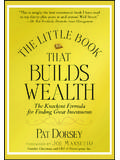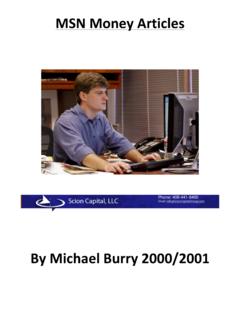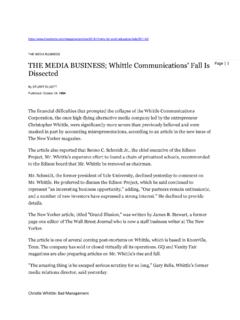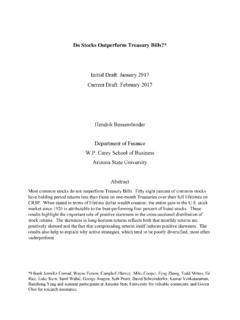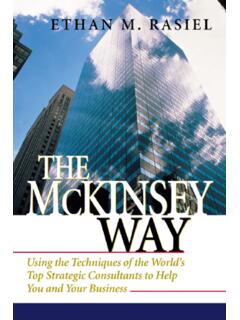Transcription of Basic Structure of Investment Process and Valuation
1 1 Basic Structure of Investment Process and ValuationProfessor Bruce Greenwald2 Value Investing Principles Identify enterprises whose value as a business is reliably calculable by you (circle of competence) Among those enterprises, invest in those whose market price (equity plus debt) is below your calculated value by an appropriate margin of safety (1/3 to 1/2)3 Value Investing ProcessSEARCH Cheap Ugly Obscure Otherwise IgnoredVALUATION Assets Earnings Power FranchiseREVIEW Key Issues Collateral Evidence Personal BiasesRISK MANAGEMENT Margin of Safety Some Diversification Patience Default Strategy45 Systematic Biases1. InstitutionalzHerding Minimize DeviationszWindow Dressing (January Effect)zBlockbusters2. IndividualzLoss AversionzHindsight BiaszLotteries6 Value Investing ProcessSEARCH Cheap Ugly Obscure Otherwise IgnoredVALUATION Assets Earnings Power FranchiseREVIEW Key Issues Collateral Evidence Personal BiasesRISK MANAGEMENT Margin of Safety Some Diversification Patience Default Strategy7 Valuation Approaches Ratio AnalysisCash Flow MeasureEarnings(Maint.)
2 Inv. = Depr + A)EBIT(Maint. Inv. = Depr + A; Tax =0)EBIT - A(Maint. Inv. = Depr only)EBIT-DA(Maint. Inv. = 0)MultipleDepends on: Economic position Cyclical situation Leverage Mgmt. Quality Cost of Capital (Risk) GrowthxRange of Error (100%+)8 Valuation ApproachesNet Present Value of Cash FlowValue= CFt=CF011 + R()t1R - g * t=0 Note: NPV Analysis encompasses ratio analysis(NPVdiseases are ratio analysis diseases)Note: NPV is theoreticallycorrectRevenuesMarginsRequi red InvestmentsCash FlowsCost of CapitalNPV </> Market ValueForces:zConsumer BehaviorzCompetitor BehaviorzCost PressureszTechnologyzTechzManagement PerformanceParameters:zMarket SizezMarket SharezMarket GrowthzPrice/CostzTechzManagement PerformanceIn Practice:X9 Shortcomings of NPV Approach in Practice(1) Method of Combining Information (2) Sensitivity Analysis is Based on Difficult-to-Forecast Parameters which co-vary in fairly complicated waysNPV = CFo+CF111 + R1 + R+.
3 +CF20201+ ..Good Information (Precise)= Bad/Imprecise InformationBad Information (Imprecise)Profit MarginCost of CapitalGrowthRequired Investment10 Valuation AssumptionsTraditional: Profit rate 6% Cost of capital 10% Investment /sales 60% Profit rate +3% ( 9%) Growth rate 7% of sales, profitsStrategic: Industry is economically viable Entry is Free (no incumbent competitive advantage) Firm enjoys sustainable competitive advantage Competitive advantage is stable, firm grows with industry11 Value InvestingBasic Approach to Valuation Know what you know ; Circle of competence1. Organize Valuation components by reliabilityMost ReliableLeast Reliable2. Organize Valuation components by underlying strategic assumptionNo Competitive Growing CompetitiveAdvantage Advantage12 Basic Elements of ValueStrategic DimensionGrowth in Franchise OnlyFranchise ValueCurrent Competitive AdvantageFree EntryNo Competitive AdvantageAsset ValueEarnings Power Value Tangible Balance Sheet Based No Extrapolation Current Earnings Extrapolation No Forecast Includes Growth Extrapolation ForecastReliability DimensionTotal Value13 Industry Entry - ExitRemember, Exit is Slower than Value Net Asset ValueEntryChemicals$2B$1 BYes (P MV )(Allied)$ $1 BYes$ $1 BStopAutomobiles$40B$25 BYes (Sales MV )(Ford)
4 $30B$25 BYes$25B$25 BStopInternet$10B$ ValueAssetsCashBookBookAccounts Receivable BookBook + AllowanceInventoriesBookBook + LIFOPPE0 Orig Cost AdjProduct Portfolio0 Years R & DCustomer Relationships0 Years SGAO rganization0 Licenses, Franchises0 Private Mkt. ValueSubsidiaries0 Private Mkt. ValueLiabilitiesA/P, AT, ALBookBookDebtBookFair MarketDef Tax, ReservesBookDCFB ottom LineNet Net Wk CapNet Repro ValueReproduction ValueBasic Graham-Dodd Value15 Earning Power ValuezBasic Concept Enterprise value based on this years Earnings zMeasurement- Earnings Power Value = Earnings zSecond most reliable information earnings todayzCalculation Earnings Accounting Income + Adjustments Cost of Capital = WACC (Enterprise Value) Equity Value = Earnings Power Value : Current profitability is sustainable1 Cost of capital*16 Earning Power Calculation(1)Start with Earnings not including accounting adjustments (one-time charges not excluded unless policy has changed)(2) Earnings are Operating earnings (EBIT)(3)Look at averagemargins over a business/Industry cycle (at least 5 years)(4)Multiply average margins by sustainable (usually current) revenues This yields normalized EBIT(5)Multiply by one minus Averagetax rate (no pat)(6)Add back excess depreciation(after tax at average tax rate) This yields normalized Earnings(7)
5 Add adjustments for unconsolidated subs, problem being fixed, pricing power, etc17 Earnings Power ValueEPV Business Operations = Earnings Power x 1/WACCEPV Company = EPV Business Operations + Excess Net Assets(+cash, +real estate, - legacy costs)EPV Equity = EPV Company Value DebtEPV EQUITY equivalent to AV EQUITYEPV COMPANY equivalent to AV COMPANY18 Earning Power and Entry - ExitAsset ValueEP ValueCase B:Free EntryIndustry BalanceCase A:Asset ValueEP ValueValue Lost to Poor Management and/or Industry DeclineAsset ValueEP ValueCase C:Consequence of Comp. Advantage and/or Superior Management Sustainability depends on Continuing Barriers-to-Entry19 Total Value Including GrowthzLeast reliable - Forecast change not just stability (Earnings Power)zHighly sensitive to assumptionszData indicates that investors systematically overpay for growthzStrict value investors want growth for Free (Market Value < Earnings Power Value)20 Value of Growth - Basic Forces At Work Growing Stream of Cash flows is more Valuable than a Constant Stream (relative to current cash flow ) Growth Requires Investment which reduces current (distributable) Cash CF0vs.
6 CF01R - G*1R*WACCG rowth RateCF0= Earnings yInvestment Needed to Support GrowthNo Growth CF0( Do Not Discount Growing Earnings Streams)21 Value of GrowthQuantitative EffectsInvestment: $100 millionCost of Funds: 10% (R) = $10 MReturn on Investment (%)5%10%20%Return on Investment ($)$5M$10M$20 MCost of Investment $10M$10M$10 MNet Income Created($5M)0$10 MNet Value Created($50M)0$100 MQualitative Impact:Situation:Value DestroyedCompetitive DisadvantageNo ValueLevel Playing FieldValue CreatedCompetitive Advantage22 Earning Power and Entry - ExitAsset ValueEP ValueCase B:Free EntryIndustry BalanceCase A:Asset ValueEP ValueValue Lost to Poor Management and/or Industry DeclineAsset ValueEP ValueCase C:Consequence of Comp. Advantage and/or Superior Management Sustainability depends on Continuing Barriers-to-Entry23 Valuing Growth BasicszGrowth at a competitive disadvantage destroys value (AT&T in info processing)zGrowth on a level playing field neither creates nor destroys value (Wal-Mart in NE)zOnly franchise growth (at industry rate) creates value24 Value Investing ProcessSEARCH Cheap Ugly Obscure Otherwise IgnoredVALUATION Assets Earnings Power FranchiseREVIEW Key Issues Collateral Evidence Personal BiasesRISK MANAGEMENT Margin of Safety Some Diversification Patience Default Strategy25 Consequences of Free EntryCommodity Markets (Steel)$/QQFirm PositionPriceAC Economic Profit ROE (20%)
7 > Cost of Capital Entry/ExpansionSupply Up, Price Down$/QQFirm PositionPriceAC(Efficient Producers)ROE = 12%No EntryNo Profit26 Product DifferentiationBranding(Profitability & Stability)Coca ColaCadillacColgate ToothpasteMercedes-BenzTideSony (RCA)MarlborosMaytag(Hoover)BudweiserHar ley-DavidsonIntelMotorolaDell, HPTarget, WalmartGap, Liz ClaiborneVerizon, CingularATT, SprintWellsFargo, NCNBJP Morgan, Chase, CitibankInsuranceCosmeticsGannett, Buffalo Evening NewsNY Times, WSJ27 Consequences of Free EntryDifferentiated Markets (Luxury Cars)$/QQFirm PositionDemand CurveAC Economic Profit ROE (20%) > Cost of Capital Entry/ExpansionDemand for Firm shifts left (Fewer sales at each Price)$/QQFirm PositionDemand CurveACROE = 12%No EntryNo Profit28 Barriers to EntryIncumbent Cost AdvantageEntrantIncumbentSourcesNo Economic ProfitROE = 12%No Entry Economic ProfitROE = 20%Proprietary Tech(Patent, Process )Learning CurveSpecial Resources Not Access to Capital Not Just Smarter$/QQFirm PositionDemand (Entrant, Incumbent)ACEntrantACIncumbent29 Barriers to EntryIncumbent Demand AdvantageEntrantIncumbentSourcesNo Economic ProfitROE = 12%No EntryHigher Profit, SalesROE = 20%Habit (Coca-Cola) High Frequency PurchaseSearch Cost (MD s) High Complex QualitySwitching Cost (Banks, Computer Systems) Broad Embedded ApplicationsDemandIncumbentDemandEntrant AC (Entrant, Incumbent)
8 $/QFirm PositionQ30 Barriers to EntryEconomies of Scale Require Significant Fixed Cost (Internet) Require Temporary Demand Advantage Not the Same as Large Size (Auto + Health Care Co)$/QFirm PositionEntrantIncumbentQACD emandFirm PositionQACD emand (Entrant, Incumbent)$/QNo advantageNo advantage31 Barriers to EntryEconomies of Scale Advantages are Dynamic and Must be Defended Fixed Costs By: Geographic Region (Coors, Nebraska Furniture Mart, Wal-Mart) Product Line (Eye Surgery, HMO s) National (Oreos, Coke, Nike, Autos) Global (Boeing, Intel, Microsoft)Q$/QACP rice (Both)Sales EntrantSales IncumbentD-EntrantProfitD-IncumbentLoss3 2 Varieties of Competitive AdvantageProducer (Cost) Supply Proprietary Technology or ResourcesConsumer (Revenue) Demand Customer CaptivityEconomies-of-Scale (plus Customer Captivity)Key to SustainabilitySustainable Competitive Advantage implies market Advantage Strategy Implications Analysis on a market-by-market basis Large global markets are difficult to dominate Localmarkets (Physical, product geography) are ones susceptible to domination Microsoft (Apple, IBM) Wal-Mart (K-Mart, Circuit City)
9 Intel (Texas Instruments, et al) Verizon (ATT, Sprint) Pharmaceuticals34 Assessing Competitive Advantages/B-to-E Strategy Formulation New Market Entry-No Barrier No Profit-Outside Barriers Losses-Need Potential Barriers, not yet in place. Maintaining Established Position-No Barriers No Position (Hard to Create from Nothing).-Enhancement Product Line Extension Increase Purchase Frequency Increase Complexity Accelerate Progress Emphasize Fixed vs. Variable Cost Technology. 35 Procedure in Practice(1) Verify existence of Returns Share competitive advantages(2) Calculate earnings return 1/PE(3) Identify cash distribution portion of earnings return(4) Identify organic (low Investment ) growth(5) Identify reinvestment return(6) Compare to market return (D/P & growth)(7) Identify options positive/negative(GDP )(Dividend + Repurchase)(Multiple of Pct retained Earnings )36 Prospective Returns US & India Market(1)6% (1/PE) + 2% (inflation) = 8%(2) (D/P) + (growth) = Return = Market(1)4% (1/PE) + 5% (inflation) = 9%(2)2% (D/P) + 7% (growth) = 9%Expected Return = 9%37 Hindustan Unilever: Market Dominance37 Source.
10 Company website showing AC Nielsen Quarter Ended Sept 2007 value shares3838 Hindustan Unilever: Financial returns(Indian Rupees)20022003200420052006 Revenues crores10951,6111096,02 10888,38 11975,53 13035,06 Net profit margin16%16%11%11%12%Return on on Assets23%23%16%20%20%Stock informationMarket cap (crores)40,00845,059 31,587 43,419 47,788P/E Ratio2325263126 Share : PerformanceReturn on Total Capital *As Earnings Per Share* grew ..25 . Stock Price ($US ADR) shows extremely high multiples / growth expectation, especially in 2000 ..39*

